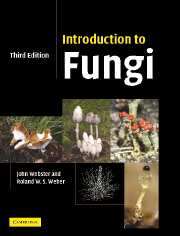Book contents
- Frontmatter
- Contents
- Preface to the first edition
- Preface to the second edition
- Preface to the third edition
- Acknowledgements
- 1 Introduction
- 2 Protozoa: Myxomycota (slime moulds)
- 3 Protozoa: Plasmodiophoromycota
- 4 Straminipila: minor fungal phyla
- 5 Straminipila: Oomycota
- 6 Chytridiomycota
- 7 Zygomycota
- 8 Ascomycota (ascomycetes)
- 9 Archiascomycetes
- 10 Hemiascomycetes
- 11 Plectomycetes
- 12 Hymenoascomycetes: Pyrenomycetes
- 13 Hymenoascomycetes: Erysiphales
- 14 Hymenoascomycetes: Pezizales (operculate discomycetes)
- 15 Hymenoascomycetes: Helotiales (inoperculate discomycetes)
- 16 Lichenized fungi (chiefly Hymenoascomycetes: Lecanorales)
- 17 Loculoascomycetes
- 18 Basidiomycota
- 19 Homobasidiomycetes
- 20 Homobasidiomycetes: gasteromycetes
- 21 Heterobasidiomycetes
- 22 Urediniomycetes: Uredinales (rust fungi)
- 23 Ustilaginomycetes: smut fungi and their allies
- 24 Basidiomycete yeasts
- 25 Anamorphic fungi (nematophagous and aquatic forms)
- References
- Index
- Plate section
10 - Hemiascomycetes
- Frontmatter
- Contents
- Preface to the first edition
- Preface to the second edition
- Preface to the third edition
- Acknowledgements
- 1 Introduction
- 2 Protozoa: Myxomycota (slime moulds)
- 3 Protozoa: Plasmodiophoromycota
- 4 Straminipila: minor fungal phyla
- 5 Straminipila: Oomycota
- 6 Chytridiomycota
- 7 Zygomycota
- 8 Ascomycota (ascomycetes)
- 9 Archiascomycetes
- 10 Hemiascomycetes
- 11 Plectomycetes
- 12 Hymenoascomycetes: Pyrenomycetes
- 13 Hymenoascomycetes: Erysiphales
- 14 Hymenoascomycetes: Pezizales (operculate discomycetes)
- 15 Hymenoascomycetes: Helotiales (inoperculate discomycetes)
- 16 Lichenized fungi (chiefly Hymenoascomycetes: Lecanorales)
- 17 Loculoascomycetes
- 18 Basidiomycota
- 19 Homobasidiomycetes
- 20 Homobasidiomycetes: gasteromycetes
- 21 Heterobasidiomycetes
- 22 Urediniomycetes: Uredinales (rust fungi)
- 23 Ustilaginomycetes: smut fungi and their allies
- 24 Basidiomycete yeasts
- 25 Anamorphic fungi (nematophagous and aquatic forms)
- References
- Index
- Plate section
Summary
Introduction
The class Hemiascomycetes contains the classical ascomycete yeasts, exclusive of those which belong to the Archiascomycetes (see the preceding chapter) and the ‘black yeasts’ such as Aureobasidium (see p. 486). Detailed descriptions of the individual yeast genera and species are given in Kurtzman and Fell (1998) and Barnett et al. (2000). A useful taxonomic overview is that by Kurtzman and Sugiyama (2001). There is only one order, the Saccharomycetales, which has been divided into 11 families and 276 species (Kirk et al., 2001; Kurtzman & Sugiyama, 2001). However, detailed phylogenetic analyses of the Hemiascomycetes (Kurtzman & Robnett, 1998, 2003) indicate that this family arrangement is likely to be modified in the future, and for this reason we shall focus on selected genera.
The key feature that distinguishes the Hemi- and Archiascomycetes from the higher ascomycetes (Euascomycetes) is that ascogenous hyphae and an ascocarp, i.e. an investment of sterile hyphae surrounding the asci, are lacking in the first two groups. Instead, the asci are formed freely and singly, either directly following karyogamy or more rarely after a prolonged diploid phase. Another distinguishing feature is the composition of the cell wall, which contains very little chitin in the Hemi- and Archiascomycetes. Chitin is often confined to a small ring around the site where the daughter cell is produced (the bud scar). An ultrastructural feature of distinction concerns the septal pore of any hypha that may be produced.
- Type
- Chapter
- Information
- Introduction to Fungi , pp. 261 - 284Publisher: Cambridge University PressPrint publication year: 2007

